


A New Art Idea with Each
Shake of Your Phone/Tablet
A New Art Idea with Each Shake of Your Phone/Tablet
A New Art Idea with Each Shake of Your Phone/Tablet
Shake your device to stir up a unique combination of art elements to inspire new works. Go with the random elements or make your own selections on each Art Wheel.
If you select one element on each of the first 11 Art Wheels, you get one of 67 billion possible approaches to art making! If 67B is not enough for you, you can always use the 12th wheel to choose one of 7 ways to juxtapose two or more approaches for practically infinite possibilities!
Tap on any one of the art elements on the Art Wheels to learn more about that element.
We hope Shake the Muse contributes to a growing recognition that the elements of art don’t belong to past artists or historical periods. Rather, each is a timeless, essential part of visual language, belonging to all. In the late 19th century and throughout the 20th century, western culture celebrated individuality and the exploration of visual language. This freed artists from past constraints, allowing them to respond to their own experiences and the times in which they lived. However, one art element after another came to be seen as the property of an artist or perhaps a group of artists. (Surely, dots belong to the Pointillists!) Soon enough, most elements of visual language supposedly belonged to individuals or movements and thus the past — their timelessness seemingly lost.
In the 21st century, we're responding to worlds of information at our fingertips. AI can easily mock-up anything we can imagine. Anything goes. Judging by the diversity of contemporary art, last century's proprietary attitude regarding the elements of art seems to be fading away. We're beginning to celebrate the broadest scope of human creativity, recognizing a need and a desire to draw on all parts of visual language to fully express ourselves.
Those still attached to 20th century notions of originality need not worry that free exploration of visual language will lead to derivative art. It's easy enough to see when an artist mimics a past master or period – trying to repeat all the same nuances of that artist or era. Originality can be found in the countless subtle choices an artist makes while working within a set of parameters. And now, with the full scope of visual language to play with, we can always find new parameters – just…
If you select one element on each of the first 11 Art Wheels, you get one of 67 billion possible approaches to art making! If 67B is not enough for you, you can always use the 12th wheel to choose one of 7 ways to juxtapose two or more approaches for practically infinite possibilities!
Tap on any one of the art elements on the Art Wheels to learn more about that element.
We hope Shake the Muse contributes to a growing recognition that the elements of art don’t belong to past artists or historical periods. Rather, each is a timeless, essential part of visual language, belonging to all. In the late 19th century and throughout the 20th century, western culture celebrated individuality and the exploration of visual language. This freed artists from past constraints, allowing them to respond to their own experiences and the times in which they lived. However, one art element after another came to be seen as the property of an artist or perhaps a group of artists. (Surely, dots belong to the Pointillists!) Soon enough, most elements of visual language supposedly belonged to individuals or movements and thus the past — their timelessness seemingly lost.
In the 21st century, we're responding to worlds of information at our fingertips. AI can easily mock-up anything we can imagine. Anything goes. Judging by the diversity of contemporary art, last century's proprietary attitude regarding the elements of art seems to be fading away. We're beginning to celebrate the broadest scope of human creativity, recognizing a need and a desire to draw on all parts of visual language to fully express ourselves.
Those still attached to 20th century notions of originality need not worry that free exploration of visual language will lead to derivative art. It's easy enough to see when an artist mimics a past master or period – trying to repeat all the same nuances of that artist or era. Originality can be found in the countless subtle choices an artist makes while working within a set of parameters. And now, with the full scope of visual language to play with, we can always find new parameters – just…
Shake your device to stir up a unique combination of art elements to inspire new works. Go with the random elements or make your own selections on each Art Wheel.
If you select one element on each of the first 11 Art Wheels, you get one of 67 billion possible approaches to art making! If 67B is not enough for you, you can always use the 12th wheel to choose one of 7 ways to juxtapose two or more approaches for practically infinite possibilities!
Tap on any one of the art elements on the Art Wheels to learn more about that element.
We hope Shake the Muse contributes to a growing recognition that the elements of art don’t belong to past artists or historical periods. Rather, each is a timeless, essential part of visual language, belonging to all. In the late 19th century and throughout the 20th century, western culture celebrated individuality and the exploration of visual language. This freed artists from past constraints, allowing them to respond to their own experiences and the times in which they lived. However, one art element after another came to be seen as the property of an artist or perhaps a group of artists. (Surely, dots belong to the Pointillists!) Soon enough, most elements of visual language supposedly belonged to individuals or movements and thus the past — their timelessness seemingly lost.
In the 21st century, we're responding to worlds of information at our fingertips. AI can easily mock-up anything we can imagine. Anything goes. Judging by the diversity of contemporary art, last century's proprietary attitude regarding the elements of art seems to be fading away. We're beginning to celebrate the broadest scope of human creativity, recognizing a need and a desire to draw on all parts of visual language to fully express ourselves.
Those still attached to 20th century notions of originality need not worry that free exploration of visual language will lead to derivative art. It's easy enough to see when an artist mimics a past master or period – trying to repeat all the same nuances of that artist or era. Originality can be found in the countless subtle choices an artist makes while working within a set of parameters. And now, with the full scope of visual language to play with, we can always find new parameters – just…
If you select one element on each of the first 11 Art Wheels, you get one of 67 billion possible approaches to art making! If 67B is not enough for you, you can always use the 12th wheel to choose one of 7 ways to juxtapose two or more approaches for practically infinite possibilities!
Tap on any one of the art elements on the Art Wheels to learn more about that element.
We hope Shake the Muse contributes to a growing recognition that the elements of art don’t belong to past artists or historical periods. Rather, each is a timeless, essential part of visual language, belonging to all. In the late 19th century and throughout the 20th century, western culture celebrated individuality and the exploration of visual language. This freed artists from past constraints, allowing them to respond to their own experiences and the times in which they lived. However, one art element after another came to be seen as the property of an artist or perhaps a group of artists. (Surely, dots belong to the Pointillists!) Soon enough, most elements of visual language supposedly belonged to individuals or movements and thus the past — their timelessness seemingly lost.
In the 21st century, we're responding to worlds of information at our fingertips. AI can easily mock-up anything we can imagine. Anything goes. Judging by the diversity of contemporary art, last century's proprietary attitude regarding the elements of art seems to be fading away. We're beginning to celebrate the broadest scope of human creativity, recognizing a need and a desire to draw on all parts of visual language to fully express ourselves.
Those still attached to 20th century notions of originality need not worry that free exploration of visual language will lead to derivative art. It's easy enough to see when an artist mimics a past master or period – trying to repeat all the same nuances of that artist or era. Originality can be found in the countless subtle choices an artist makes while working within a set of parameters. And now, with the full scope of visual language to play with, we can always find new parameters – just…
Shake your device to stir up a unique combination of art elements to inspire new works. On desktop, just hit refresh. Go with the random elements or make your own selections on each Art Wheel.
If you select one element on each of the first 11 Art Wheels, you get one of 67 billion possible approaches to art making! If 67B is not enough for you, you can always use the 12th wheel to choose one of 7 ways to juxtapose two or more approaches for practically infinite possibilities!
Tap on any one of the art elements on the Art Wheels to learn more about that element.
We hope Shake the Muse contributes to a growing recognition that the elements of art don’t belong to past artists or historical periods. Rather, each is a timeless, essential part of visual language, belonging to all. In the late 19th century and throughout the 20th century, western culture celebrated individuality and the exploration of visual language. This freed artists from past constraints, allowing them to respond to their own experiences and the times in which they lived. However, one art element after another came to be seen as the property of an artist or perhaps a group of artists. (Surely, dots belong to the Pointillists!) Soon enough, most elements of visual language supposedly belonged to individuals or movements and thus the past — their timelessness seemingly lost.
In the 21st century, we're responding to worlds of information at our fingertips. AI can easily mock-up anything we can imagine. Anything goes. Judging by the diversity of contemporary art, last century's proprietary attitude regarding the elements of art seems to be fading away. We're beginning to celebrate the broadest scope of human creativity, recognizing a need and a desire to draw on all parts of visual language to fully express ourselves.
Those still attached to 20th century notions of originality need not worry that free exploration of visual language will lead to derivative art. It's easy enough to see when an artist mimics a past master or period – trying to repeat all the same nuances of that artist or era. Originality can be found in the countless subtle choices an artist makes while working within a set of parameters. And now, with the full scope of visual language to play with, we can always find new parameters – just…
If you select one element on each of the first 11 Art Wheels, you get one of 67 billion possible approaches to art making! If 67B is not enough for you, you can always use the 12th wheel to choose one of 7 ways to juxtapose two or more approaches for practically infinite possibilities!
Tap on any one of the art elements on the Art Wheels to learn more about that element.
We hope Shake the Muse contributes to a growing recognition that the elements of art don’t belong to past artists or historical periods. Rather, each is a timeless, essential part of visual language, belonging to all. In the late 19th century and throughout the 20th century, western culture celebrated individuality and the exploration of visual language. This freed artists from past constraints, allowing them to respond to their own experiences and the times in which they lived. However, one art element after another came to be seen as the property of an artist or perhaps a group of artists. (Surely, dots belong to the Pointillists!) Soon enough, most elements of visual language supposedly belonged to individuals or movements and thus the past — their timelessness seemingly lost.
In the 21st century, we're responding to worlds of information at our fingertips. AI can easily mock-up anything we can imagine. Anything goes. Judging by the diversity of contemporary art, last century's proprietary attitude regarding the elements of art seems to be fading away. We're beginning to celebrate the broadest scope of human creativity, recognizing a need and a desire to draw on all parts of visual language to fully express ourselves.
Those still attached to 20th century notions of originality need not worry that free exploration of visual language will lead to derivative art. It's easy enough to see when an artist mimics a past master or period – trying to repeat all the same nuances of that artist or era. Originality can be found in the countless subtle choices an artist makes while working within a set of parameters. And now, with the full scope of visual language to play with, we can always find new parameters – just…